What Tree is That?
Fabienne Taylor, Former Coordinator of Interpretive Resources
Photos by the Author
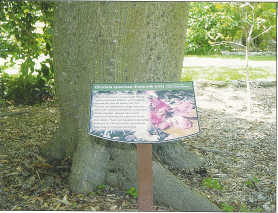 |
| Signs display plant parts that are not always present, such as flowers and fruits of the silk floss tree, Chorisia speciosa. |
Every now and then, this question is directed at me when visitors realize I am a staff member at Fairchild Tropical Botanic Garden. Until recently, there were two possible responses to this question: I could either reveal the common name of the plant to the curious visitor, or, if time allowed, try to give, in addition to the name, a little more detailed information on what makes the plant unique. Today, our visitors have another choice available to them: they can read the new signs and brochures which have been produced by the interpretation team over the past two years.
Interpretation is . . .
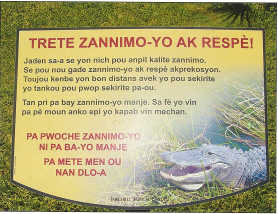 |
| Different languages are used for effective interpretation. The sign seen here is in Haitian Creole. |
. . . not translation! Unless it is understood as translation of scientific language into everyday words, interpretation, as defined by the National Association for Interpretation is "a communication process that forges emotional and intellectual connections between the interests of an audience and the inherent meaning in the resources."
There are many benefits to having interpretive signs at the Garden, including attracting visitors and increasing knowledge and awareness about plants. However, the most significant and long-term impact of interpretation is the positive image it creates with visitors, by sending the message: “We care about you.”
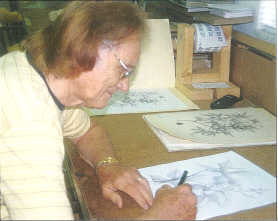 |
| Wes Jurgens designed the royal poinciana icon seen on the McLamore Arboretum signs. |
The difference a little interpretation can make
If you have taken a walk recently in the Garden, you may have noticed the new signs. I hope you took the time to read them. You may be surprised to learn that there are now well over 100 signs placed throughout the various exhibits.
Interpretive signage is a good way to reach visitors who walk through the Garden. The first signs were produced in 2001 for the Richard H. Simons Rainforest. The interpretation team has since developed interpretation for the McLamore Arboretum, the Montgomery Palmetum, and the Jewels of the Caribbean exhibits. Additional signs have been created for plants with interesting stories, such as the cannonball tree (Couroupita guianensis), the gumbo limbo (Bursera simaruba), and the coontie (Zamia integrifolia), to name only a few.
Creating interpretive signage
How is it done? The recipe seems very easy: you write some text for the plant you want to interpret, you take a picture of the plant, then put these two together and voila! Sounds simple, right? The process is actually much more complex than you might think.
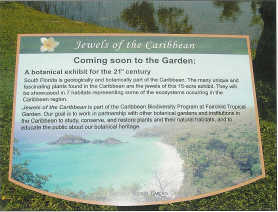 |
| This sign describes an exhibit that is being developed. |
Interpretation is A. R. T.
“A” is for Audience
One of the first decisions to be made in producing interpretive material is to identify the target audience and the method of interpretation which will be adopted (signage, brochure, audioguide, video, etc.). This initial step is the primary basis for the development of any sound and qualitative interpretation.
“R” is for Resources
When creating a new interpretation project, a committee tailored to that project is formed. The committee is staffed with a mix of people from various departments of the Garden. The Garden's botanists and horticulturalists are continually contributing their expertise; their collaboration is essential to the project. Occasionally professionals from other organizations are also consulted. Members of the interpretive committee hold brainstorming sessions to develop a theme or main message, and sub-themes for the exhibit. One basic principle of interpretation is "people remember themes, they forget facts." For instance, after reading the signs in the Palmetum, a visitor may remember that palms are very diverse, but may not remember that there are 2,500 species of palms in the world.
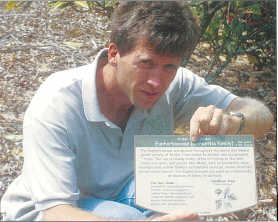 |
| Benoit Jonckheere, Curator of the McLamore Arboretum and part of the interpretation team, points out the text on a new sign. |
“T” is for Techniques
Following the creation of a team and the selection of a theme, a concise, information-rich text addressing the theme and sub-themes is written over the course of several meetings. Then the final interpretive materials are produced.
The text is the result of thorough discussions leading to a consensus reached by the committee members. Some components are almost always present: scientific names, common names, origin and uses. Before the text is released to be made into interpretive materials, final revisions are made for space, style and grammar.
The signs placed throughout the Garden have been created in-house by the interpretation team, using graphic design software. The style is consistent: a heading banner including an icon and border colors characteristic of each exhibit are used for all signs. Images are always included. Signs are shaped with a user-friendly, beveled edge.
All signs are first produced on a temporary basis, using a film of adhesive vinyl mounted on a special type of plastic material. These temporary signs will be evaluated as to their effectiveness and will be updated as needed. In all cases, the ultimate goal is to use revelation of information and provocation of interest, not instruction, in order to have visitors relate to the interpretive material by referring to their own experience.
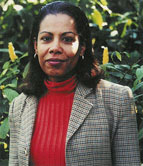 |
| Fabienne Taylor |
Don't forget
We tend to remember
- 90% of what we say and do,
- 70% of what we say,
- 50% of what we hear and see,
- and only 10% of what we read.
Garden Views Summer 2003